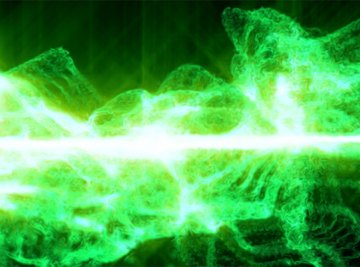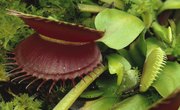
Glow sticks, those ubiquitous, disposable toys sold at ballparks and party stores, are more than just fun to look at. They are actually superb examples of a simple chemical experiment. However, there are other scientific endeavors that you can undertake using glow sticks. These science fair projects will expand your knowledge about the science behind the glowing party favors.
Make Your Own Glow Stick
One of the best ways to understand the science involved in glow sticks is to make one yourself at home. Glow sticks work through a process called chemiluminescence, whereby the mixing of two chemicals creates light. For this project you will need 2 liters distilled water, 50 milliliters hydrogen peroxide, 0.4 g 3 percent copper sulfate pentahydrate, 4 g sodium carbonate, 0.2 g luminol and 0.2 g ammonium carbonate. You will also need two large mixing bowls, a glass stirrer, large test tube or graduated cylinder, safety goggles, gloves and protective clothing.
Pour 1 liter of distilled water and the hydrogen peroxide into a large mixing bowl and stir. Pour the other liter of water, sodium carbonate, copper sulfate pentahydrate, luminol and aluminum carbonate into the other bowl and stir. Pour 1/2 cup of both solutions into the test tube or cylinder. The solution will glow for only a few seconds.
Temperature Effect on Glow Sticks
One popular belief about glow sticks is that if you put them in the freezer, the glowing reaction will last longer. You can test that theory with this experiment. Expose three sets of glow sticks to different temperatures. Take three sets of five glow sticks and snap them to activate the reaction. Place one set in a bowl filled with 1 liter of ice water. Place another set in a bowl filled with 1 liter of hot (not boiling) water. Leave the third set on a counter at room temperature. Turn off the lights in the room and close any curtains, then start a stopwatch. Record the time it takes for each set of sticks to extinguish and observe results.
Glowstick Effect on Plants
For this project, you want to examine the effect of glow sticks on plants to see if the light produced by glow sticks can substitute for the sunlight that plants need to grow. You will need three, identical plant specimens and several glow sticks. The study will take one week. One plant will be exposed to constant sunlight for the duration of the project. The second plant will be exposed to sunlight for three days and 12 hours and then to light from only glow sticks the for remainder of the week. The third plant will be exposed to only glow sticks for the week. Observe any effects on each plant.
Military Use of Glow Sticks
The U.S. military uses a form of high-tech glow stick for nighttime missions to help soldiers see each other in the pitch black darkness. You can conduct an experiment to test the effectiveness of glow sticks for this purpose. You will need several packages of glow sticks (enough for about 50 glow sticks) and plenty of outdoor space. Activate the glow sticks and hold them (or perhaps glue them to a disposable painter's uniform). Have a partner measure the distance at which the light is visible at night. See how far away you have go to before the light becomes hard to see.
References
About the Author
Jeremy Cato is a writer from Atlanta who graduated with Phi Beta Kappa honors and an English degree from Morehouse College. An avid artist and hobbyist, he began professionally writing in 2011, specializing in crafts-related articles for various websites.
Photo Credits
Jupiterimages/Photos.com/Getty Images
